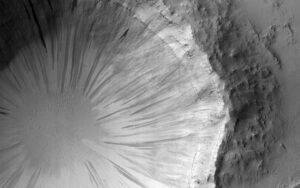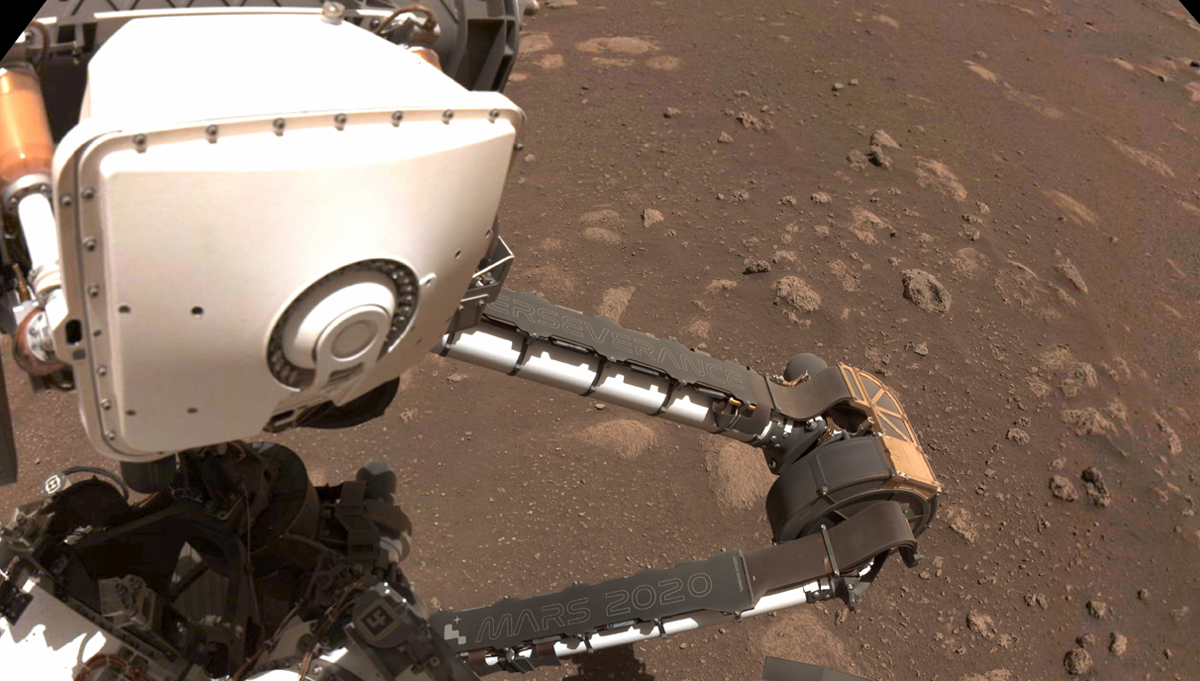
These dark streaks, also known as "slope streaks," are in an area of Mars known as Acheron Fossae. The source of these features is a topic of a recent machine learning research project. Credit: NASA
Researchers cross-check curious features with temperature, geological features, and wind speed data to check key theory.
In the late 1970s, scientists reviewing images of Mars from NASA’s Viking 1 spacecraft, made a curious discovery. The images, crude by modern standards, revealed long, dark streaks snaking down some Martian slopes, sometimes for hundreds of feet.
NASA had been sending spacecraft to Mars for a decade by then, but knowledge of the Red Planet was building slowly. What the dark streaks were, or what they might mean, would remain a mystery for another 20 years.
When NASA’s Mars Global Surveyor and Mars Reconnaissance Orbiter (MRO) missions began transmitting more detailed images in the late 1990s and early 2000s, scientists finally had enough information to begin decoding the mystery and formulate theories.

This image from NASA’s Mars Reconnaissance Orbiter (MRO) shows streaks forming on slopes when dust cascades downhill.
Credit: NASA
The features are known as slope streaks and recurring slope lineae (RSLs). Slope streaks are dark surface markings that appear spontaneously on steep, dusty terrain and gradually fade over years or decades. RSLs, discovered more recently in 2011, are shorter-lived, seasonal streaks that appear during the warmest times of the Martian year and vanish just as mysteriously as they form.
The surface of Mars is arid and cold, with an average global temperature of about -83°F. Scientists believe that the planet was once more temperate and could have held considerable surface water. High-resolution images from NASA’s MRO mission reveal formations that indicate the presence of running water millions of years ago. What became of that water is still a key question.
There is water ice under the surface of Mars. NASA captured dramatic evidence of this on December 24, 2021, when a meteoroid between 16 to 39 feet across streaked through the thin Martian atmosphere and collided violently with the surface. The area around the impact site was strewn with ejected boulders of ice. It was the closest to the equator that scientists had seen evidence of ice.
Some scientists have theorized that both slope streaks and RSLs could be the result of some form of water on Mars—perhaps melting salty water ice or brines seeping from beneath the surface.
Recently, researchers from Brown University and the University of Bern examined more than 86,000 high-resolution images from the Context Camera aboard NASA’s MRO, one of the most powerful imaging platforms ever launched. Using machine learning, scientists Adomas Valantinas and Valentin Bickel produced a global catalog of more than 500,000 individual slope streaks.

Boulder-size blocks of water ice can be seen around the rim of this giant meteoroid impact crater on Mars, as viewed by the High-Resolution Imaging Science Experiment (HiRISE camera) aboard NASA’s Mars Reconnaissance Orbiter. Credit: NASA/JPL-Caltech/University of Arizona
“Once we had this global map, we could compare it to databases and catalogs of other things like temperature, wind speed, hydration, rockslide activity and other factors,” said Valentin Bickel, a post-doctoral fellow at the Center for Space and Habitability at the University of Bern. “Then we could look for correlations over hundreds of thousands of cases to better understand the conditions under which these features form.”
This catalog revealed that the streaks predominantly occur in dusty, low-thermal-inertia regions near Mars’ equator, with dark streaks concentrated slightly north of bright ones. Bright streaks are typically older, faded versions of the dark ones, which darken fresh slopes and then gradually lighten over time.
Scientists have observed a seasonal cycle with RSLs, in particular, which led some to consider a possible link to water. Some researchers believed the timing of their appearance in southern summer pointed to melting subsurface ice or salt-rich brines. But the analysis paints a different picture.

The steep walls of the crater are covered with slope streaks formed by material falling down towards the crater’s center. Credit: NASA/JPL-Caltech/University of Arizona
The researchers used AI to connect their global map of streaks with environmental data—such as temperature, slope orientation, surface albedo, and mineral composition. The researchers found no strong evidence supporting wet processes. Most streaks did not align with temperature spikes, high humidity, or conditions suitable for liquid water. Instead, their formation coincided with peaks in dust deposition and increased wind speeds.
“A big focus of Mars research is understanding modern-day processes… — including the possibility of liquid water on the surface,” said Valantinas, a postdoctoral researcher at Brown. “Our study reviewed these features but found no evidence of water. Our model favors dry formation processes.”
The researchers concluded that slope streaks likely form when layers of ultrafine dust suddenly slide down steep inclines. This can happen when dust accumulates to a critical point and is disturbed—by seismic activity, winds, or even the shockwaves from meteoroid impacts. There were statistically significant correlations between new impact sites and the appearance of nearby slope streaks in certain regions, supporting this view.
Interestingly, slope streaks occupy less than 0.1 percent of the Martian surface—but their impact is outsized. They are estimated to move enough dust each Martian year to rival several global dust storms, making them key players in the planet’s climate and dust cycle.
To learn more about the fascinating science from NASA’s Mars Reconnaissance Orbiter, click here.









